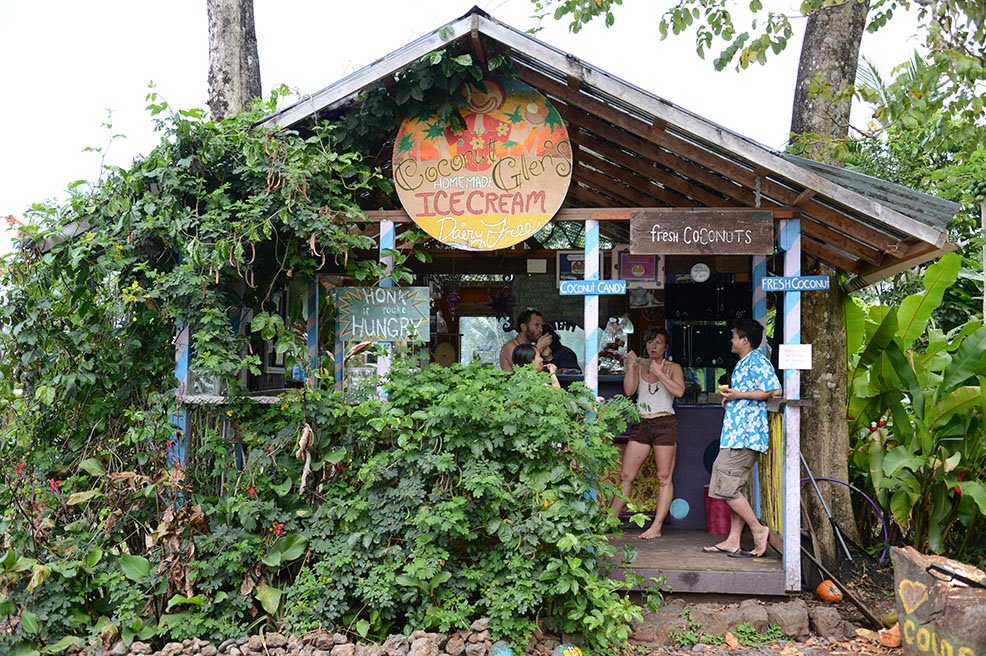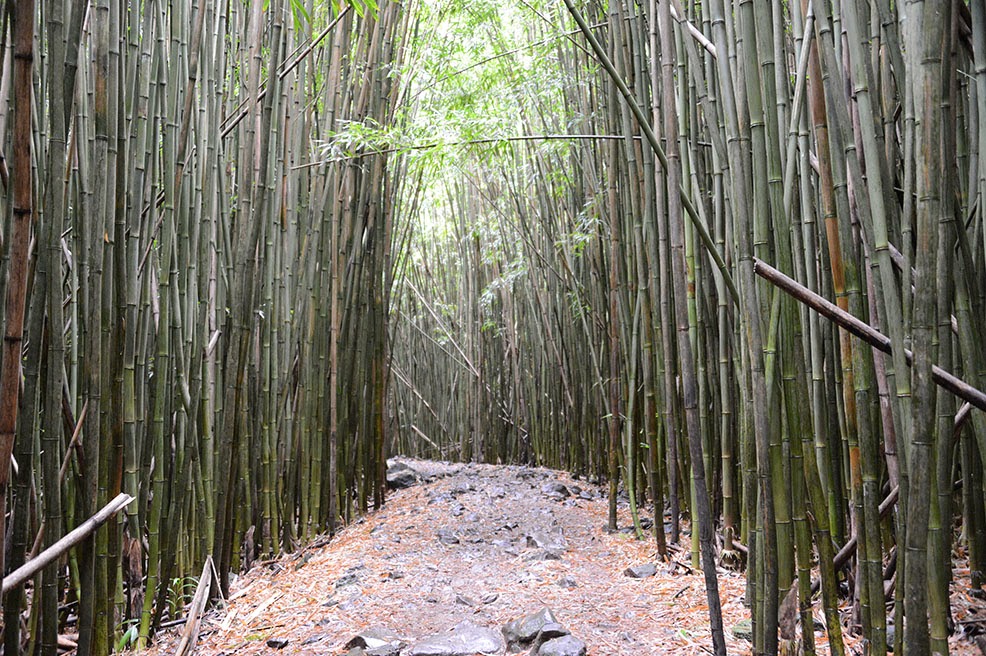We spent 2 wonderful weeks in Maui. Maui is a beautiful island and is known as the playground of Hawaii. It's reputedly the most expensive but we were lucky enough to stay on the north side, away from the large resorts, and it seemed similar to the other islands to us and often cheaper than what we're used to in Australia.
We stayed in Kuau in an apartment owned by friends of our son Simon and daughter in law Maree. They have become our friends too and were very generous in letting us use their apartment just outside the "hippie" town of Paia. We had a very enjoyable family Christmas on Maui in 2012 and decided that we would like to spend more time there and this was a great opportunity. Their apartment is in a block and looks out over palm trees and the sea in the distance. It is comfortable and easily maintained - an ideal balance.
Paia was originally a sugar cane plantation town and still has many plantation style wooden style buildings intact. It is near some great surf beaches, and has some unique shops and restaurants. One shop, Mana Foods, looks very rundown and insignificant from the outside but inside it has the most amazing selection of health food and natural products imaginable. It seems to be the centre of town and is always crowded, often with people catching up with each other in the aisles. You can expect to see many varieties of people from downright grungy to partially dressed in brief swim wear to super trendy and immaculate. I found it endlessly fascinating.
Many of you will know of Wayne Dyer who has written many self help books. I had read that he's chosen to live on Maui because he believes that it is a very spiritual place. Well we saw him at Mana and YES I was impressed. He had an amazing aura. I always feel divided as whether to approach people in this situation but on this occasion I observed him from a distance.
Many artists live and work in Maui and it was fun to look around Paia and see some of their work.
The main reason that we went to Hawaii at this time of year was because it was the middle of the whale season. Last time, when we were there at Christmas time, we thought that we saw lots of whales. However, several locals told us it wasn't really worth looking until February. Humpback whales travel from Alaska to Hawaii, arriving from late October and staying until mid May. Numbers peak in February and early March when there are approximately 12,000 in the waters on the south and west shores of Maui which is bounded by two smaller islands. The warm temperature of the water, relative shallow depth and safety from predators seems to entice them. They are quite easy to see from shore and there are many boat opportunities.
We went out mainly with the Pacific Whale Foundation. They are a non profit organisation and are doing quite a lot of whale research. It seemed logical to support them. They also have whale experts on board - often biology graduates -who were passionate about whales and had amazing knowledge about them. We mostly went out on a small boat - a zodiac - which carries about 30 people. It is close to the water and makes whale viewing more intimate. It's fairly sheltered and the water was always smooth so sea sickness was not an issue.
Mostly we chose to go out in the early morning. It meant early starts as it was about 45 minutes drive from our apartment to Lahaina where the trips started. We were told that the whales are not predictably more active at any time during the day but they are often easier to see earlier in the morning as the sea is often calmer. Seeing the sun rise from the sea is also amazing.
The first sign of whale activity is usually a splash similar to this below. Sometimes we would see splashes in more than one area and the crew would decide which ones looked the most active or interesting to travel towards. The term whale soup was used when there were three or more choices!
Hump back whales travel about 3.500 miles from the Gulf of Alaska to Hawaii in the northern winter. Some go to Mexico and Japan as well. Females give birth in the warm waters and others - non pregnant females, males and juveniles seem to come for the trip. The clear waters are nutrient free around Hawaii so the whales do not eat during their stay. They survive on their blubber or fat reserves. Pretty demanding for mothers needing to feed rapidly growing calves.
It is wonderful to see the calves copying their mothers behaviours and perfecting their skills in readiness for the long trip back to Alaska - just weeks after they are born. We watched this calf below practice slapping it's tail over and over. The staff estimated it was about 4 weeks old. It was very committed to improving it's skills.
Whales spend 90% of their time under water. We were amazed at how little is known about them and their behaviours. For example they have never been seen reproducing or giving birth and little is known about these activities. Humpbacks in particular give pretty impressive surface displays but the reasons for this are not well understood.
Whales often put their flukes or tails up when they have been above the water and are about to dive down. The flukes or underside of their tails all have different patterns enabling individual whales to be identified. The differences became very obvious to us after a while. They went from small white marks to almost all white. Researchers photograph the flukes and use them for research.
Sometimes whales bring their heads out of the water and tread water for up to a minute. This is called spy hopping and is believed to be used to check out what's happening above the water.
On every trip hydrophones were put into the water so that we could hear whales singing. The noise is great to hear. Little is known about why whales sing. What is known is that only males sing and only in the breeding season. What is more amazing to me is that all of one population sing the same song. Different populations sing different but similar songs. Songs appear to have verses and choruses and change a little from season to season. I say never under estimate the intelligence of whales.

We saw a lot of this behaviour in competition pods. Several males compete to become the primary escort to a female and have the best chance of mating with her. It can involve up to 25 males. We saw up to about 10. They jostle, head butt each other, bump heads etc. They do not harm each other and do not fight to the death. These tussles can go on for many hours. They are largely gentle creatures and have been seen assisting each other when needed. A whale was observed holding a dead whale up to the surface with it's pectoral fin, presumably to let it breathe, for many hours off Maui a few years ago.
Lots of action in the competition pods.
In a more genteel way we watched mothers swimming with their new calves, often with a male escort. These escorts are not the fathers of the calves but it's presumed that they are hoping to mate with the females who've given birth. They will often help to protect the calves as well. Apparently only 7% of females who give birth get pregnant again in the same year so these males do not have great odds of success it seems to me!
Bob was in photographers paradise taking photos. It's challenging because you can never be quite sure when they will do something amazing. Some of their behaviour e.g. the competition pods are fascinating to watch but not great to photograph. Bob took about 500 photos on most trips - often on a sequence of up to five per second. I feel very fortunate that I could watch and observe in real time but still have the photographic memories provided by Bob.
These are the best of the best of his photos.
This is two whales breaching together about 25 metres from the boat. Breaches happen without warning so Bob was lucky to be facing in the right direction with his camera ready. It was over so quickly I did not realise that there were two whales until I saw the photos.
The whale above jaw clapping in a competition pod - an aggressive behaviour where they open their jaw and clap it together sometimes making a loud noise.
And another breach on a different day. So close that you can see the barnacles under it's head.
Sunsets from the shore over the water were beautiful and different every night.




























































